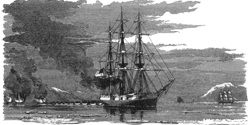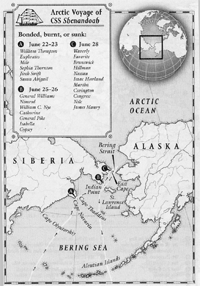|
The First Blow is Struck: The Saga of the CSS Shenandoah
 |
|
The Shenandoah towing prisoners from three burning whaling vessels in Behring's Straits, June 25, 1865. (Alaska State Library - Historical Collections)
|
The Civil War would seem to be an unlikely topic in a discussion of the remote Western Arctic, but events of 1865 in the Bering Sea and Strait had a profound effect on the whaling industry in this region and in New England. Early in the War, the Confederacy embarked on a plan to commission twelve “commerce raiders”, ships that had as their primary mission to undermine the economy of the North by seizing and destroying vessels owned by Northern companies, particularly whaling ships. The Northern economy relied heavily on ships to carry goods and supplies; raw materials to supply Northern factories, manufactured goods to markets around the world, and supplies for the war effort. According to Stephen Mallory, the Confederate Secretary of the Navy and a proponent of the strategy, whaling “constitutes one of (the North’s) most reliable sources of national wealth.”
 |
|
Shenandoah in the Western Arctic
(from Chaffin 2006)
|
Having a considerably smaller Navy than the North, and few Southern shipbuilding facilities, the Confederacy worked in secrecy at ports in Europe to find and refit ships that would expand and modernize their Navy. The Sea King, a British steamer, was surreptitiously purchased by the South and, renamed the Shenandoah, successfully struck a blow that undermined Yankee whaling, and through this, the economy of the North, beyond all expectations. Ironically, most of this blow was struck after the war was over.
Slipping out of the Thames River and headed literally around the world in search of prizes, between October 1864 and November of 1865 the Shenandoah seized a total of 38 ships of commerce, and burned 32 to the waterline. Prowling the Western Arctic, over a period of less than a week in late June of 1865, the Shenandoah captured 24 whaling ships and sunk 20 in the waters near the Bering Strait. The Shenandoah’s captain, James Waddell, and his officers did not believe reports from the vessels they were destroying that the war had already ended, some three months earlier. All ships’ personnel from these captured vessels, numbering over a thousand according to the ship’s records, were released unharmed, and only two of the crew of the Shenandoah lost their lives during the epic voyage. The total loss to the whaling industry was estimated at $1.4 million ($19.7 million in 2000 dollars)
Three well-written books on the Shenandoah story have been published in the last few years: Schooler, Lynn (2005). The Last Shot. HarperCollins, New York, 308pp.; Chaffin, Tom (2006). Sea of Gray. Hill and Wang, New York, 432 pp.;and Baldwin, John and Ron Powers (2007). Last Flag Down. Random House, New York, 354 pp.
|